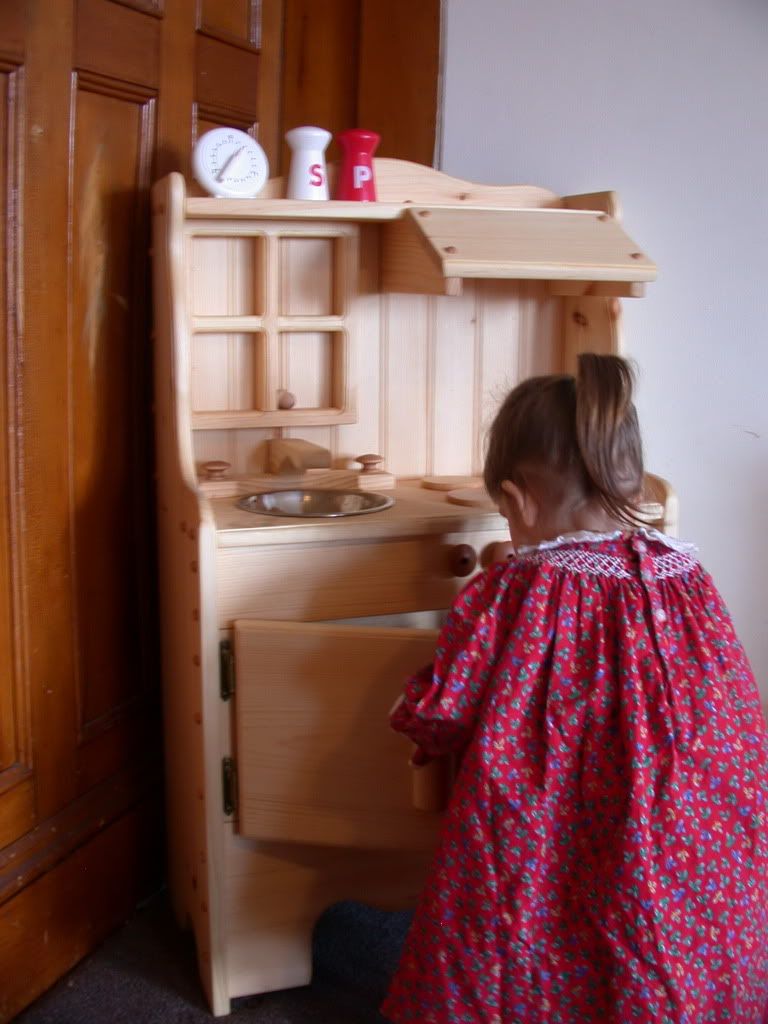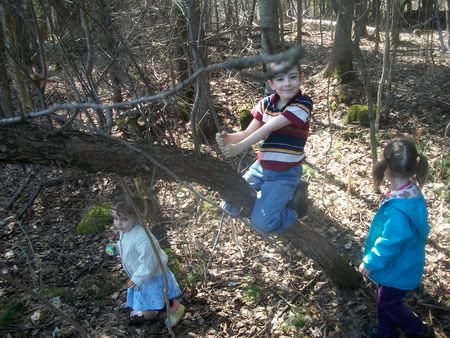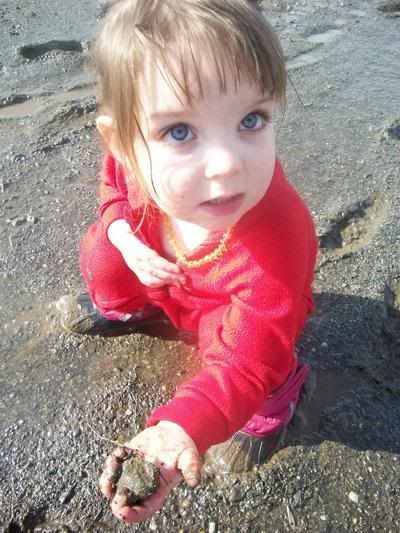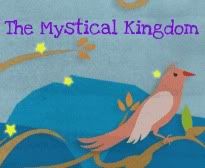Don't forget to check out the Amazing Giveaway for a Handfelted Wool Spring Basket ....Ends March 14th!!!
INDOORS
Creative Play
Circle Time & Games
Hand Work & Crafts
Childrens Yoga
Cooking & Bread Baking
Festivals and Celebrations
Daily snacks
Watercolor Painting
Storytelling (including puppetry and plays)
OUTDOORS
Organic Gardening
Outdoor Play
CREATIVE PLAY
I always provide a beautiful array of handmade toys.My little ones love picking through the hand dyed silks of rainbow colors, fine hand-carved and painted animals, natural wooden tree blocks, wool crowns & more. Their play is limitless. Sometimes the kiddos decide to put on their gnome hats, divide the “magic stones” amongst themselves and go treasure hunting with their tool sacks; in the next moment I may find them building “Ireland” with their toys and cloths and everyone is excited as they add to the towns and land in hopes of catching a leprechaun.
CIRCLE TIME & GAMES
We love circle time; it is a highlight of our morning. Most of our circles include the unfolding of a story, told through songs involving a great deal of movement. We incorporate puppetry and various games. We create our circles with the intention of using the whole body through movement and exploring the space around us, building body/space awareness. Children learn to move with cadence as they hop, skip, stomp and clap. They learn the beginnings of counting, adding and subtracting in a joyful manner through games, songs, finger plays and dividing up silks and other items used during circle time or play. It is one of the silliest and best ways to start the day....
HAND WORK & CRAFTS
Our handwork activities involve practicing fine motor skills and developing newly discovered abilities. Handwork activities may include finger knitting, beeswax modeling, clay work, stitching (and repairing), making homemade play dough, and learning dry or wet felting. We enjoy making crafts in celebration of seasonal changes, such as the harvest and making cornhusk dolls or making autumn gnomes for the nature table. We may make things for one another as gifts and some are pieces of work created together to use in our program (such as puppet making, making beeswax figures for our nature table or making clothing for the dolls).
YOGA
Using our bodies and imaginations, we integrate and weave together storytelling, music and language in a way that engages the whole child. My children are excited at the chance to become a butterfly on a great adventure changing into opening flowers, standing as a strong tall tree and stretching like a dog or becoming other animals along the way.
Yoga helps develop childrens concentration, coordination, body awareness, flexibility and balance. While doing Yoga, children become more connected with their inner self as they deepen their relationship with the natural world around them. They truly feel what it might be like if they were a snake moving about without arms or legs. When children imitate the sounds and movements of nature, they have the opportunity to take on the qualities and become another being. They learn, through becoming another being, a deeper understanding that we are all connected. For example, when a child assumes the pose of the lion, they relate to the lion by experiencing the power and behavior of the animal all while experiencing their own inner power. The children experience the strength and force associated with aggression, and then withdraw to an inner state of calm.
Yoga has many benefits and is a great gift to give to our young children. It is a noncompetitive physical activity fostering self-esteem and body awareness while encouraging cooperation.
COOKING & BAKING
Through cooking, baking and food preparation, children begin learning Practical life skills, such as pouring, stirring, chopping and measuring (learning the beginnings of number recognition). Children find great joy and satisfaction in preparing their own foods. We prepare different types of nutritious foods with the children. Through this experience, the children learn to love and appreciate new and healthy foods.
WATERCOLOR PAINTING
EXPRESSION, PAINTING AND SPIRITUAL DEVELOPMENT
One must surround their children with beauty. Watercolors naturally create very beautiful works without technical talent. Watercolor paints remind me of the silk scarves that parents are encouraged to use as drapes over their babies’ cradles. When children are small, their perception of the physical world is still veiled. Most young children are not able to perceive strict realism. They are still emerging from their spiritual womb. This emergence will continue until the child is well into adulthood.
ORGANIC GARDENING
Gardening furthers the child’s ability to follow the rhythms in nature. Plants have the power to change our lives. They provide simple and therapeutic pleasure. Caring for our garden allows the child to observe the changes and cycles in plants from the beginning stages of planting through the harvesting and eating. Vegetables, fruits, flowers & trees, butterflies, birds and insects all participate in raising the child’s awareness of the processes of life. Through careful care, children begin to understand the importance of the earth’s elements & the effects of the sun, wind, rain and soil on our tender plants. We express appreciation for all who take part in farming and providing foods for our table.
OUTDOOR PLAY
We make it a priority to spend part of each day outdoors, regardless of the weather. All weather is good weather if we are properly dressed. Children need the fresh air and some require the ability to play loud. Outdoor play offers children new challenges for growth and development. Children climb, run, jump and balance. They can shovel snow and build structures with large, wooden building blocks in the warmer months. We work together raking, digging, and moving objects. Children live by their will, their action. They learn by watching the teachers do their work and are carried along in the activity through their desire to imitate. Children love playing love playing outdoor games together. Other fun activities may include hula hooping, jump rope, chalk & balls. Children also have lots of fun running and playing. When it is raining the children love to splash in the rain and jump in puddles. Only on the coldest/very rainy days do we stay inside....
Don't forget to check out the Amazing Giveaway for a Handfelted Wool Spring Basket ....Ends March 14th!!!
Showing posts with label routines. Show all posts
Showing posts with label routines. Show all posts
Thursday, February 23, 2012
Thursday, June 24, 2010
Preschool and Kindergarten ~ Where to begin
There is no curriculum for a child of that age. However there are many wonderful things you can do to give your child what is truly the "best start".
What a child of this age needs is rhythm, repetition and an active home life where Mommy allows her to participate. Helping you with your daily work, cooking, sweeping, etc. is the best curriculum you can offer. Neurophysiological researchers are finally confirming what wise parents and teachers have always known, that the first seven years provide a foundation for all of life.
Toddlers and Preschoolers love to model your behavior and their play consists of acting out everything they take in from their surroundings, therefore the surroundings you create must be worthy of this imitation. Are you doing your housework with a "whistle while you work" attitude, or are you setting her in front of the TV or telling her not to bother you while you are busy. Many parents do not realize that young helpers grow to be willing participants in life whereas children who are told to step aside grow to be lazy and unwilling to lift a finger when it's time to help.

You must be conscious and awake to what your child is taking in. Is the TV off? Does she have her own tools to work alongside you in the kitchen, garden, etc.? At our house we realize the importance of little hands helping so we have small sized cutting boards, knives, gardening tools, rakes, brooms and so forth all around the house.
These items are an investment in the child's education because they ARE the curriculum for this age group. Children also love to cook and play with dough. Bake bread, make soup, go to market and discuss what you are buying, and why. (Not with scientific explanations, but rather to give the child some sensory experiences. Example: "Oh my, look at all of these lovely apples. Which should be choose for our lovely cake?" and then smell them point out the bruised ones and behave as though the bunch you chose were the best of the lot - and what a great eye for apple picking your little one has!)
A child this age imitates, so provide creative opportunities where she can imitate you. There isn't much need for any explaining or discussion... Just go about your work, humming a sweet tune and soon your child will be working happily alongside you. She is watching you and wants to do as you do, so be aware of HOW you go about your work. Your child is learning how to behave and how to react during this time.
Children of this age also delight in simple movement games, nursery rhymes and finger plays. If you want to feel like you need to "do something" as far as "curriculum", Than an informal circle is a good addition to your day.

Allow your child to play. provide silks, stones, clips and indulge her wanting to build castles and hiding spaces. Allow your child's imagination to take over and try not to "instruct" your child on things at this age. When I worked as a parent toddler leader, I was so saddened by the parents who had to tell their child everything.
They never allowed their children to explore or discover anything for themselves. The child would pick up a simple wooden block and begin to play and the parent would rush over "Oh, I see you have a block, what are you going to do with that?" - Meanwhile, for all we know, the child imagined it to be a piece of fruit, a person, a friend... Parents and children often quickly became agitated and the children would react by behaving in anti social ways. So allow your child to wonder and to imagine, to dream. Step back from the feeling that you must explain everything... now is not the time.
Finally, rhythm, rhythm, rhythm. This is KEY in the life education of any child. The child needs to know what she can count on, and know her place in her world. She just blossoms when there is order and simplicity and she feels good following a routine. Do you have a daily rhythm? A weekly rhythm? A seasonal rhythm? Do you celebrate festivals and holidays with your child fully involved?
In closing, I wanted to add that you should feel good that your child is home with you and know that in itself is the best start. While children from deprived homes may benefit from a nursery program, the IDEAL for toddlers and preschoolers is a stable, secure and loving home life with a parent who provides and encourages satisfying and creative activities for the child.
Friday, May 21, 2010
Daily Rhythms & Routines

Rhythm
Having a daily rhythm does not mean following the clock. "Rhythm and human life cannot be separated. Plants, animals and human beings all reveal rhythmical qualities in form, movement and growth patterns. Humankind moves through life embraced by great, rhythmical "tides" - the cosmic pulling of the planets, nature's rhythms of day, night and seasons and the biological rhythm of heart and lungs." (Quote taken from Natural Childhood: The First Practical Holistic Guide for Parents of the Developing Child. We highly recommend this outstanding book for a deeper understanding of rhythm and a fully "Waldorf" childhood.
"Rhythm" is not the same as "Schedule"
It is important to understand that "rhythms" are not really like schedules and/or time tables... but more like the flow of the way the day begins, continues, closes, etc... If your rhythm at dinner is to set the table, light a candle, say a blessing and eat the meal, then if it's at 5:00 one night and then at 6:30 the next night because daddy is running late or the beans aren't cooked, but you still follow the pattern of setting the table, lighting the candle, saying the blessing and eating... then you DO have a rhythm.
It happens like the tide, in a more natural way as opposed to watching he clock and the race against time, which I feel causes unnecessary stress, pressure, and so forth. I think as a home schooling parent... THIS is one of the biggest issues of school for me. This lesson from 9:45 through 10:30 then break and go on to that lesson from 10:45 through lunch.... meanwhile, it seems that it breaks up JUST when the creative energy and/or inspiration begins to flow!!!
It is likely that you already have plenty of rhythms set in place and are just scared away by the term itself, or how it was presented to you... Just think of your daily chores, work, necessary things you do (brushing teeth, getting ready for bed, etc...) I am sure that with a bit of conscious observation, you'll discover many rhythms already set in place at your home!
Seasonal Rhythm
January brings the snow
Makes our feet and fingers glow.
February brings the rain
Thaws the frozen lake again.
March brings breezes, loud and shrill,
Stirs the dancing daffodil.
April brings the primrose sweet,
Scatters daisies at our feet.
May brings flocks of pretty lambs,
Skipping by their fleecy dams.
June brings tulips, lilies, roses,
Fills the children's hands with posies.
Hot July brings cool showers,
Strawberries and Sunflowers.
August brings the sheaves of corn,
Then the harvest home is borne.
Warm September brings the fruit,
Sportsmen then begin to shoot.
Fresh October brings a pheasant,
Then to gather nuts is pleasant.
Dull November brings the blast;
Then the leaves are whirling fast.
Chill December brings the sleet,
Blazing fire and Christmas treat.
Makes our feet and fingers glow.
February brings the rain
Thaws the frozen lake again.
March brings breezes, loud and shrill,
Stirs the dancing daffodil.
April brings the primrose sweet,
Scatters daisies at our feet.
May brings flocks of pretty lambs,
Skipping by their fleecy dams.
June brings tulips, lilies, roses,
Fills the children's hands with posies.
Hot July brings cool showers,
Strawberries and Sunflowers.
August brings the sheaves of corn,
Then the harvest home is borne.
Warm September brings the fruit,
Sportsmen then begin to shoot.
Fresh October brings a pheasant,
Then to gather nuts is pleasant.
Dull November brings the blast;
Then the leaves are whirling fast.
Chill December brings the sleet,
Blazing fire and Christmas treat.
Labels:
circle time,
homeschool,
rhythms,
routines,
schedules,
seasons,
waldorf,
waldorf circle time
Saturday, April 18, 2009
Daily Rhythms & Routines
Rhythm
Having a daily rhythm does not mean following the clock. "Rhythm and human life cannot be separated. Plants, animals and human beings all reveal rhythmical qualities in form, movement and growth patterns. Humankind moves through life embraced by great, rhythmical "tides" - the cosmic pulling of the planets, nature's rhythms of day, night and seasons and the biological rhythm of heart and lungs." (Quote taken from Natural Childhood: The First Practical Holistic Guide for Parents of the Developing Child. We highly recommend this outstanding book for a deeper understanding of rhythm and a fully "Waldorf" childhood.
"Rhythm" is not the same as "Schedule"
It is important to understand that "rhythms" are not really like schedules and/or time tables... but more like the flow of the way the day begins, continues, closes, etc... If your rhythm at dinner is to set the table, light a candle, say a blessing and eat the meal, then if it's at 5:00 one night and then at 6:30 the next night because daddy is running late or the beans aren't cooked, but you still follow the pattern of setting the table, lighting the candle, saying the blessing and eating... then you DO have a rhythm.
It happens like the tide, in a more natural way as opposed to watching he clock and the race against time, which I feel causes unnecessary stress, pressure, and so forth. I think as a home schooling parent... THIS is one of the biggest issues of school for me. This lesson from 9:45 through 10:30 then break and go on to that lesson from 10:45 through lunch.... meanwhile, it seems that it breaks up JUST when the creative energy and/or inspiration begins to flow!!!
It is likely that you already have plenty of rhythms set in place and are just scared away by the term itself, or how it was presented to you... Just think of your daily chores, work, necessary things you do (brushing teeth, getting ready for bed, etc...) I am sure that with a bit of conscious observation, you'll discover many rhythms already set in place at your home!
Seasonal Rhythm
January brings the snow
Makes our feet and fingers glow.
February brings the rain
Thaws the frozen lake again.
March brings breezes, loud and shrill,
Stirs the dancing daffodil.
April brings the primrose sweet,
Scatters daisies at our feet.
May brings flocks of pretty lambs,
Skipping by their fleecy dams.
June brings tulips, lilies, roses,
Fills the children's hands with posies.
Hot July brings cool showers,
Strawberries and Sunflowers.
August brings the sheaves of corn,
Then the harvest home is borne.
Warm September brings the fruit,
Sportsmen then begin to shoot.
Fresh October brings a pheasant,
Then to gather nuts is pleasant.
Dull November brings the blast;
Then the leaves are whirling fast.
Chill December brings the sleet,
Blazing fire and Christmas treat.
Makes our feet and fingers glow.
February brings the rain
Thaws the frozen lake again.
March brings breezes, loud and shrill,
Stirs the dancing daffodil.
April brings the primrose sweet,
Scatters daisies at our feet.
May brings flocks of pretty lambs,
Skipping by their fleecy dams.
June brings tulips, lilies, roses,
Fills the children's hands with posies.
Hot July brings cool showers,
Strawberries and Sunflowers.
August brings the sheaves of corn,
Then the harvest home is borne.
Warm September brings the fruit,
Sportsmen then begin to shoot.
Fresh October brings a pheasant,
Then to gather nuts is pleasant.
Dull November brings the blast;
Then the leaves are whirling fast.
Chill December brings the sleet,
Blazing fire and Christmas treat.
Labels:
circle time,
homeschool,
routines,
waldorf,
waldorf circle time
A great Collection of Waldorf Verses Part 1
Here are some of our favorites:( Please note I am not the author of these I am not sure who is but the have been taught to me if you know who wrote them please feel free to contact me so I can place credit to where it goes. Thanks)
* * * * * * *
My hands upon my head I place,
On my shoulders, on my face,
On my lips, by my side,
Then behind me they will hide.
Then I will hold them way up high,
And let my fingers quickly fly,
Hold them down in front of me,
Then I'll clap them, one, two, three.
On my shoulders, on my face,
On my lips, by my side,
Then behind me they will hide.
Then I will hold them way up high,
And let my fingers quickly fly,
Hold them down in front of me,
Then I'll clap them, one, two, three.
* * * * * * *
Two little feet go tap, tap, tap,
Two little hands go clap, clap, clap.
A quiet little leap up from my chair.
Two little arms reach high in the air.
Two little feet go jump, jump.. jump,
Two little fists go thump, thump, thump.
Then we all put on a golden crown,
And last of all sit quietly down.
Two little hands go clap, clap, clap.
A quiet little leap up from my chair.
Two little arms reach high in the air.
Two little feet go jump, jump.. jump,
Two little fists go thump, thump, thump.
Then we all put on a golden crown,
And last of all sit quietly down.
* * * * * * *
Tick, the clock says; tick, tick, tick,
What you have to do, do quick!
Time is gliding fast away,
Let us work and work today.
What you have to do, do quick!
Time is gliding fast away,
Let us work and work today.
* * * * * * *
I'm standing, I'm sitting,
I'm writing, I'm knitting,
I'm reading, I'm counting,
I'm swimming, I'm mounting.
I'm eating, I'm drinking,
I'm talking, I'm thinking,
I'm giving, I'm taking,
I'm laughing, I'm looking
I'm washing, I'm cooking
I'm driving, I'm rowing,
I'm kneeling, I'm growing.
I show my right hand
I show my left hand,
I show both my hands
And now I sit still.
I'm writing, I'm knitting,
I'm reading, I'm counting,
I'm swimming, I'm mounting.
I'm eating, I'm drinking,
I'm talking, I'm thinking,
I'm giving, I'm taking,
I'm laughing, I'm looking
I'm washing, I'm cooking
I'm driving, I'm rowing,
I'm kneeling, I'm growing.
I show my right hand
I show my left hand,
I show both my hands
And now I sit still.
* * * * * * *
A wise old owl
Lived in an Oak
The more he saw
The less he spoke
The less he spoke
The more he heard
Why can't we be
Like that wise old bird.
My hands upon my head I place
On my shoulders, on my face
On my hips I place them so
Now I raise them up so high
Make my fingers fairly fly
Now I clap them, one, two three
Now I fold them silently.
Lived in an Oak
The more he saw
The less he spoke
The less he spoke
The more he heard
Why can't we be
Like that wise old bird.
My hands upon my head I place
On my shoulders, on my face
On my hips I place them so
Now I raise them up so high
Make my fingers fairly fly
Now I clap them, one, two three
Now I fold them silently.
* * * * * * *
Labels:
fall poems,
first grade,
homeschool,
kindergarten,
music,
preschool,
routines,
songs,
verses,
waldorf,
waldorf music
Subscribe to:
Posts (Atom)
















